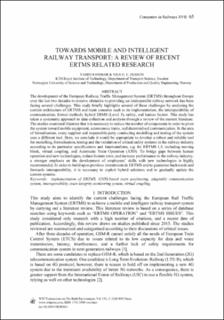Towards mobile and intelligent railway transport: a review of recent ERTMS related research
Journal article, Peer reviewed
Published version

Åpne
Permanent lenke
https://hdl.handle.net/11250/2680127Utgivelsesdato
2020Metadata
Vis full innførselSamlinger
Sammendrag
The development of the European Railway Traffic Management System (ERTMS) throughout Europe over the last two decades to remove obstacles to providing an interoperable railway network has been facing several challenges. This study briefly highlights several of these challenges by analysing the current architecture of ERTMS and main concerns such as its implementation, the interoperability of communication, formal methods, hybrid ERMS (Level 3), safety, and human factors. This study has taken a systematic approach to data collection and analysis through a review of the current literature. The studies examined illustrate that it is necessary to reduce the number of components in order to pivot the system toward mobile equipment, autonomous trains, and decentralised communication. In the area of formalisation, every supplier and responsible party conducting modelling and testing of the system uses a different tool. Here, we conclude it would be appropriate to develop a robust and reliable tool for modelling, formalisation, testing and the validation of critical safety systems in the railway industry according to its particular specifications and functionalities, e.g. for ERTMS L3, including moving block, virtual coupling, and Automatic Train Operation (ATO). To bridge gaps between human operation and new technologies, reduce human error, and increase performance in the railway industry, a stronger emphasis on the development of employees’ skills with new technologies is highly recommended. In order to build upon previous investments in ERTMS and to guarantee backwards and forwards interoperability, it is necessary to exploit hybrid solutions and to gradually update the current systems.